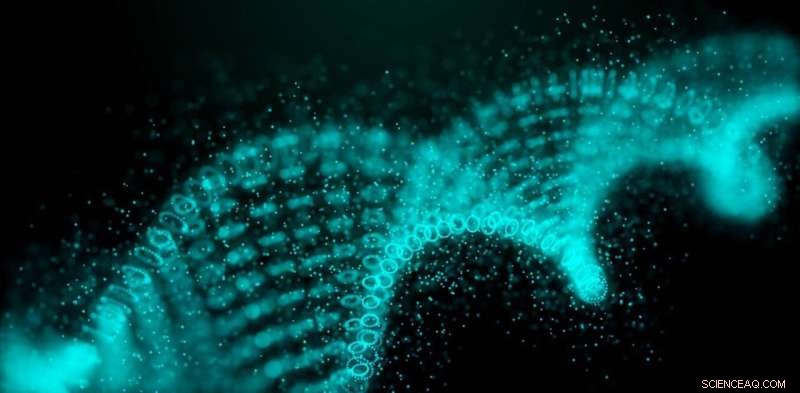
Wetenschap
DNA wordt vaak gebruikt bij het oplossen van misdaden. Maar hoe werkt DNA-profilering eigenlijk?

Krediet:thinkhubstudio/Shutterstock
DNA-profilering is regelmatig in het nieuws. De publieke belangstelling wordt gewekt wanneer DNA wordt gebruikt om een verdachte of menselijke resten te identificeren, of wanneer een cold case wordt opgelost die bijna vergeten lijkt.
Heel af en toe komt het in de media wanneer het proces niet werkt zoals het zou moeten.
Dus wat is DNA-profilering en hoe werkt het - en waarom werkt het soms niet?
Een korte geschiedenis van DNA-profilering
DNA-profilering, zoals het sinds 1994 bekend is, wordt sinds het einde van de jaren tachtig in het strafrechtssysteem gebruikt en werd oorspronkelijk "DNA-vingerafdrukken" genoemd.
Het DNA in elk mens lijkt erg op elkaar - zelfs tot 99,9% identiek. Maar vreemd genoeg is ongeveer 98% van het DNA in onze cellen niet gen-gerelateerd (d.w.z. heeft geen bekende functie).
Dit niet-coderende DNA bestaat grotendeels uit sequenties van de vier basen waaruit het DNA in elke cel bestaat.
Maar om onbekende redenen worden sommige delen van de reeks herhaald:een voorbeeld is TCTATCTATCTATCTATCTA waar de reeks TCTA vijf keer wordt herhaald. Hoewel het aantal keren dat deze DNA-sequentie wordt herhaald binnen een persoon constant is, kan het per persoon verschillen. De ene persoon heeft misschien 5 herhalingen, maar een andere 6, of 7 of 8.
Er zijn een groot aantal varianten en alle mensen vallen in een van hen. De detectie van deze herhalingen is de basis van moderne DNA-profilering. Een DNA-profiel is een lijst met getallen, gebaseerd op de herhaalde reeksen die we allemaal hebben.
Het gebruik van deze korte herhalingssequenties (de technische term is "korte tandemherhaling" of STR) begon in 1994 toen de Britse Forensic Science Service vier van deze regio's identificeerde. De kans dat twee willekeurig genomen mensen in de populatie dezelfde herhalingsaantallen zouden delen in deze vier regio's was ongeveer 1 op 50.000.
Nu is het aantal bekende herhalingssequenties enorm uitgebreid, waarbij de nieuwste test naar 24 STR-regio's kijkt. Het gebruik van alle bekende STR-regio's resulteert in een oneindig kleine kans dat twee willekeurige mensen hetzelfde DNA-profiel hebben. And herein lies the power of DNA profiling.
How is DNA profiling performed?
The repeat sequence will be the same in every cell within a person—thus, the DNA profile from a blood sample will be the same as from a plucked hair, inside a tooth, saliva, or skin. It also means a DNA profile will not in itself indicate from what type of tissue it originated.
Consider a knife alleged to be integral to an investigation. A question might be "who held the knife"? A swab (cotton or nylon) will be moistened and rubbed over the handle to collect any cells present.

Swabbing an item left at a crime scene can easily yield enough cells to generate a DNA profile. Credit:Fuss Sergey/Shutterstock
The swab will then be placed in a tube containing a cocktail of chemicals that purifies the DNA from the rest of the cellular material—this is a highly automated process. The amount of DNA will then be quantified.
If there is sufficient DNA present, we can proceed to generate a DNA profile. The optimum amount of DNA needed to generate the profile is 500 picograms—this is really tiny and represents only 80 cells!
How foolproof is DNA profiling?
DNA profiling is highly sensitive, given it can work from only 80 cells. This is microscopic:the tiniest pinprick of blood holds thousands of blood cells.
Consider said knife—if it had been handled by two people, perhaps including a legitimate owner and a person of interest, yet only 80 cells are present, those 80 cells would not be from only one person but two. Hence there is now a less-than-optimal amount of DNA from either of the people, and the DNA profiling will be a mixture of the two.
Fortunately, there are several types of software to pull apart these mixed DNA profiles. However, the DNA profile might be incomplete (the term for this is "partial"); with less DNA data, there will be a reduced power to identify the person.
Worse still, there may be insufficient DNA to generate any meaningful DNA profile at all. If the sensitivity of the testing is pushed further, we might obtain a DNA profile from even a few cells. But this could implicate a person who may have held the knife innocently weeks prior to an alleged event; or be from someone who shook hands with another person who then held the knife.
This later event is called "indirect transfer" and is something to consider with such small amounts of DNA.
What can't DNA profiling do?
In forensics, using DNA means comparing a profile from a sample to a reference profile, such as taken from a witness, persons of interest, or criminal DNA databases.
By itself, a DNA profile is a set of numbers. The only thing we can figure out is whether the owner of the DNA has a Y-chromosome—that is, their biological sex is male.
A standard STR DNA profile does not indicate anything about the person's appearance, predisposition to any diseases, and very little about their ancestry.
Other types of DNA testing, such as ones used in genealogy, can be used to associate the DNA at a crime scene to potential genetic relatives of the person—but current standard STR DNA profiling will not link to anyone other that perhaps very close relatives—parents, offspring, or siblings.
DNA profiling has been, and will continue to be, an incredibly powerful forensic test to answer "whose biological material is this"? This is its tremendous strength. As to how and when that material got there, that's for different methods to sort out.
 De ontbrekende massa - wat veroorzaakt een geoïde laag in de Indische Oceaan?
De ontbrekende massa - wat veroorzaakt een geoïde laag in de Indische Oceaan? Wetenschappers registreren snel koolstofverlies door opwarmende veengebieden
Wetenschappers registreren snel koolstofverlies door opwarmende veengebieden Welke planten leven in rivieren en beken?
Welke planten leven in rivieren en beken?  Aardbevingen in Indonesische provincie verwoest in december
Aardbevingen in Indonesische provincie verwoest in december Het eet alles - het nieuwe soort wildvuur dat onmogelijk te voorspellen is
Het eet alles - het nieuwe soort wildvuur dat onmogelijk te voorspellen is
Hoofdlijnen
- Een enkel eiwit controleert verouderingssignalen effectiever dan in een team
- Intelligente microscopen voor het detecteren van zeldzame biologische gebeurtenissen
- Insecten kunnen mensen leren omgaan met tegenslag
- Onderzoekers ontwikkelen eerste duurzame chromosoomveranderingen bij muizen
- Belangrijke plantensoorten kunnen belangrijk zijn voor het ondersteunen van bestuivers van wilde bloemen
- Een kungfu-kick leidde onderzoekers naar 's werelds oudste complete visfossielen. Dit is wat ze hebben gevonden
- Eerste muismodel met mitochondriale tRNALeu-mutatie ontwikkeld
- Hoe Spaced Repetition examen tijd een fluitje van een cent kan maken
- Waar ontwikkelt een Zygote in planten zich in?
- Wat de olifantshaai ons kan vertellen over progesteron

- Waarom liegen mensen over dingen die gemakkelijk weerlegd kunnen worden?

- Onderzoekers presenteren nieuw wiskundig model voor het bestuderen van niercellen

- De gevoeligheid van microben voor veranderingen in de omgeving hangt af van de bodemdiepte

- Wetenschappers dringen aan op bedreigde lijst van cheeta's

 Welke kracht zorgt ervoor dat een 3-polige motor de ene kant op draait en niet de andere?
Welke kracht zorgt ervoor dat een 3-polige motor de ene kant op draait en niet de andere?  Satelliet vindt tropische cycloon Bouchra herboren in Zuid-Indische Oceaan
Satelliet vindt tropische cycloon Bouchra herboren in Zuid-Indische Oceaan Ontgrendelen van efficiënte licht-energieconversie met stabiele coördinatie-nanobladen
Ontgrendelen van efficiënte licht-energieconversie met stabiele coördinatie-nanobladen Waarom R2-D2 eerder de leraar van uw kind kan zijn dan u denkt
Waarom R2-D2 eerder de leraar van uw kind kan zijn dan u denkt Onderzoek naar de luchtkwaliteit binnenshuis toont aan dat vliegtuigen tijdens de vlucht de laagste deeltjesniveaus kunnen hebben
Onderzoek naar de luchtkwaliteit binnenshuis toont aan dat vliegtuigen tijdens de vlucht de laagste deeltjesniveaus kunnen hebben Amazon lijdt aan epidemie van illegale goudmijnen
Amazon lijdt aan epidemie van illegale goudmijnen Ontwerpen van een atomaire opstelling met meerdere elementen
Ontwerpen van een atomaire opstelling met meerdere elementen Amerikaanse waarschuwingen voor zware regen, tornado's van afzwakkende storm Barry
Amerikaanse waarschuwingen voor zware regen, tornado's van afzwakkende storm Barry
- Elektronica
- Biologie
- Zonsverduistering
- Wiskunde
- French | Italian | Spanish | Portuguese | Swedish | German | Dutch | Danish | Norway |

-
Wetenschap © https://nl.scienceaq.com

